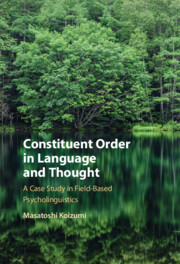
-
Select format
-
- Publisher:
- Cambridge University Press
- Publication date:
- January 2023
- January 2023
- ISBN:
- 9781108915571
- 9781108844031
- 9781108926096
- Dimensions:
- (229 x 152 mm)
- Weight & Pages:
- 0.52kg, 254 Pages
- Dimensions:
- (229 x 152 mm)
- Weight & Pages:
- 0.373kg, 252 Pages
You may already have access via personal or institutional login
Book description
Traditionally, due to the availability of technology, psycholinguistic research has focused mainly on Western languages. However, this focus has recently shifted towards a more diverse range of languages, whose structures often throw into question many previous assumptions in syntactic theory and language processing. Based on a case study in field-based comparative psycholinguistics, this pioneering book is the first to explore the neurocognition of endangered 'object-before-subject' languages, such as Kaqchikel and Seediq. It draws on a range of methods - including linguistic fieldwork, theoretical linguistic analysis, corpus research, questionnaire surveys, behavioural experiments, eye tracking, event-related brain potentials, functional magnetic resonance imaging, and near-infrared spectroscopy – to consider preferred constituent orders in both language and thought, examining comprehension as well as production. In doing so, it highlights the importance of field-based cross-linguistic cognitive neuroscientific research in uncovering universal and language-particular aspects of the human language faculty, and the interaction between language and thought.
Awards
Winner, 2024 Leonard Bloomfield Book Award, Linguistic Society of America
Contents
Metrics
Altmetric attention score
Full text views
Full text views help Loading metrics...
Loading metrics...
* Views captured on Cambridge Core between #date#. This data will be updated every 24 hours.
Usage data cannot currently be displayed.
Accessibility standard: Unknown
Why this information is here
This section outlines the accessibility features of this content - including support for screen readers, full keyboard navigation and high-contrast display options. This may not be relevant for you.
Accessibility Information
Accessibility compliance for the PDF of this book is currently unknown and may be updated in the future.


